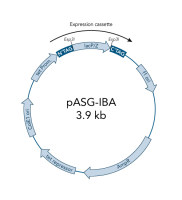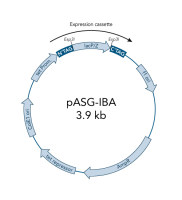Lentiviral Vector Mediated Transgenesis
互联网
- Abstract
- Table of Contents
- Materials
- Figures
- Literature Cited
Abstract
The genetic manipulation of rodents through the generation of fully transgenic animals or via the modification of selective cells or organs is a procedure of paramount importance for biomedical research, either to address fundamental questions or to develop preclinical models of human diseases. Lentiviral vectors occupy the front stage in this scene, as they can mediate the integration and stable expression of transgenes both in vitro and in vivo. Widely used to modify a variety of cells, including re?implantable somatic and embryonic stem cells, lentiviral vectors can also be directly administered in vivo, for instance in the brain. However, perhaps their most spectacular research application is in the generation of transgenic animals. Compared with the three?decade?old DNA pronuclear injection technique, lentivector?mediated transgenesis is simple, cheap, and highly efficient. Furthermore, it can take full advantage of the great diversity of lentiviral vectors developed for other applications, and thus allows for ubiquitous or tissue?specific or constitutive or externally controllable transgene expression, as well as RNAi?mediated gene knockdown. Curr. Protoc. Mouse Biol. 1:169?184. © 2011 by John Wiley & Sons, Inc.
Keywords: lentiviral vector; transgenesis; transgenic animals
Table of Contents
- Reagents and Solutions
- Commentary
- Literature Cited
- Figures
- Tables
Materials
Basic Protocol 1:
Materials
|
Figures
-
Figure 1. Specific materials required for the manipulation of embryos. A 3‐cm Petri dish with 1 ml egg medium (A ); a 3‐cm dish with six droplets of 25 µl of egg medium covered by embryo‐tested mineral oil (B ); injection chamber: one lid of a 3 cm dish with two droplets of 20 µl of egg medium covered by embryo‐tested mineral oil (C ); and a mouth pipet (D ) containing a fine capillary at its tip (E ). View Image -
Figure 2. Harvest of embryos. The dissected part of the ovary and oviduct are placed in the 3‐cm dish with 1 ml prewarmed egg medium (A ). The ampulla (Am) is the bulged part of the oviduct and is normally easily visible if the superovulation was successful. The ampulla is opened by carefully tearing the wall using fine forceps (B ), and the embryos (Em) then pop out (C ). The embryos are still surrounded by numerous small cells (D ) that the hyaluronidase disaggregates (E ). View Image -
Figure 3. Perivitelline injection of the lentiviral vector stock. An embryo is held on the left with the holding pipet and on the right the injection micropipet containing the lentiviral vector stock is introduced through the zona pellucida (A ). The injection micropipet is gently pushed into the perivitelline space (B ) and delivers 10 to 100 pl of the vector stock leading to visible swelling of the area (C ). View Image -
Figure 4. Transfer of embryos into the ampulla. Under a stereomicroscope, the ampulla (A) is held with fine forceps (F), and the embryo‐containing capillary of the mouth pipet (M) is introduced into the hole previously made with a hypodermic needle. The embryos are injected gently towards the ampulla. View Image -
Figure 5. (figure appears on previous page) Setup and analysis for the qPCR genotyping of the transgenic animals. (A ) Dilution of the pTitin plasmid standard for the qPCR titration. (B ) Example of template of the 96‐well plate for the qPCR assay. (C ) Representative qPCR analysis. Genomic DNA from transgenic mouse blood was subjected to qPCR amplification and monitoring using a Perkin‐Elmer 7900HT (Applied Biosystems) with sets of primers and probes specific for HIV Gag or Titin sequences. Amplification plots were displayed and cycle threshold values (Ct) were set as described in the text. SDS software allows calculation of the standard curve (square point) and determination of Gag and Titin quantity for each animal (cross point). Values of Gag and Titin quantities exported into an Excel worksheet. View Image -
Figure 6. Examples of some lentiviral vector designs, for gene overexpression (A ), gene knock‐down with a shRNA (B ), and gene regulation (C ). The vectors are self‐inactivating: the 5′ U3 region is from the Rous sarcoma virus (RSV); they all bear the encapsidation signal (including a short gag ‐derived sequence), the Rev‐responsive element (RRE), the central polypurine tract with its termination sequence (cPPT/cTS), and the woodchuck hepatitis virus responsive element (WPRE). “Promoter” designates the transcriptional unit responsible for expression of the transgene, and can be either ubiquitous (human phosphoglycerate kinase, hPGK; ubiquitin, UbC) or tissue specific (e.g., calmodulin‐dependent protein kinase II, CamKII; liver‐specific transthyretin, mTTR). IRES refers to the internal ribosome entry site of the encephalomyocarditis virus, which directly recruits ribosomes, thus allowing bicistronic expression. pA is a monodirectional poly(A) site derived from the bovine growth hormone gene. The reporter can be, for example, the enhanced green fluorescent protein (eGFP), or one of its variants such as CFP, YFP, dsRed, or Tomato. For gene knockdown, the shRNA is expressed under the control of the H1 or U6 polymerase III promoters. For gene regulation, one of the most powerful designs is based on the Tet‐on system allowing gene expression in the presence of doxycycline, an analog of tetracycline. The gene of interest, which can be either a cDNA or an miRNA‐embedded shRNA, is under the control of the tetracycline‐regulated minimal CMV promoter (TRE), and the tetracycline‐dependent transactivator (rtTA, or improved version such as rtTA2S‐M2) is expressed under the control of a constitutive promoter, which can also be a ubiquitous or tissue‐specific one. View Image -
Figure 7. Time flowchart for lentiviral vector mediated transgenesis. View Image
Videos
Literature Cited
| Literature Cited | |
| Barde, I., Salmon, P., and Trono, D. 2010. Production and titration of lentiviral vectors. Curr. Protoc. Neurosci. 53:4.21.1‐4.21.23. | |
| Donovan, J. and Brown, P. 2006. Euthanasia. Curr. Protoc. Immunol. 73:1.8.1‐1.8.4. | |
| Fraga D., Meulia T, and Fenster S. 2008 Real‐time PCR. Curr. Protoc. Essential Lab. Tech. 00:10.3.1‐10.3.34 | |
| Gordon, J.W., Scangos, G.A., Plotkin, D.J., Barbosa, J.A., and Ruddle, F.H. 1980. Genetic transformation of mouse embryos by microinjection of purified DNA. Proc. Natl. Acad. Sci. U.S.A. 77:7380‐7384. | |
| Jahner, D. and Jaenisch, R. 1985. Retrovirus‐induced de novo methylation of flanking host sequences correlates with gene inactivity. Nature 315:594‐597. | |
| Jahner, D., Stuhlmann, H., Stewart, C.L., Harbers, K., Löhler, J., Simon, I., and Jaenisch, R. 1982. De novo methylation and expression of retroviral genomes during mouse embryogenesis. Nature 298:623‐628. | |
| Lois, C., Hong, E.J., Pease, S., Brown, E.J., and Baltimore, D. 2002. Germline transmission and tissue‐specific expression of transgenes delivered by lentiviral vectors. Science 295:868‐872. | |
| Naldini, L., Blömer, U., Gallay, P., Ory, D., Mulligan, R., Gage, F.H., Verma, I.M., and Trono, D. 1996. In vivo gene delivery and stable transduction of nondividing cells by a lentiviral vector. Science 272:263‐267. | |
| Okada, Y., Ueshin, Y., Isotani, A., Saito‐Fujita, T., Nakashima, H., Kimura, K., Mizoguchi, A., Oh‐Hora, M., Mori, Y., Ogata, M., Oshima, R.G., Okabe, M., and Ikawa, M. 2007. Complementation of placental defects and embryonic lethality by trophoblast‐specific lentiviral gene transfer. Nat. Biotechnol. 25:233‐237. | |
| Robinson, J.P., Darzynkiewicz, Z., Hoffman, R., Nolan, J.P., Orfao, A., Rabinovitch, P.S., and Watkins, S. (eds.) 2010. Current Protocols in Cytometry. John Wiley & Sons, Hoboken, N.J. | |
| Sauvain, M.O., Dorr, A.P., Stevenson, B., Quazzola, A., Naef, F., Wiznerowicz, M., Schütz, F., Jongeneel, V., Duboule, D., Spitz, F., and Trono, D. 2008. Genotypic features of lentivirus transgenic mice. J. Virol. 82:7111‐7119. | |
| Szulc, J., Wiznerowicz, M., Sauvain, M.O., Trono, D., and Aebischer, P. 2006. A versatile tool for conditional gene expression and knockdown. Nat. Methods 3:109‐116. | |
| Tiscornia, G., Singer, O., Ikawa, M., and Verma, I.M. 2003. A general method for gene knockdown in mice by using lentiviral vectors expressing small interfering RNA. Proc. Natl. Acad. Sci. U.S.A. 100:1844‐1848. | |
| WHO. 2004. Laboratory Biosafety Manual, 3rd ed. World Health Organization, Geneva. | |
| Wolf, D. and Goff, S.P. 2007. TRIM28 mediates primer binding site‐targeted silencing of murine leukemia virus in embryonic cells. Cell 131:46‐57. |






